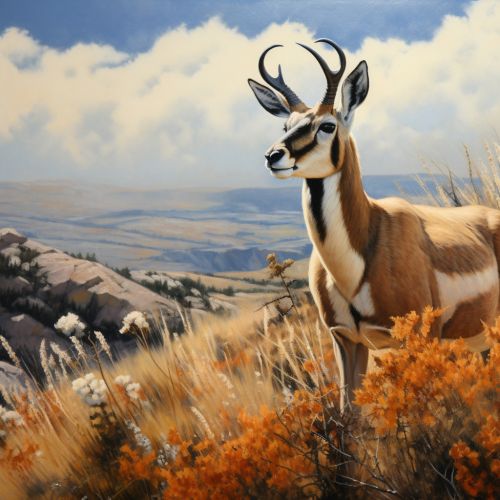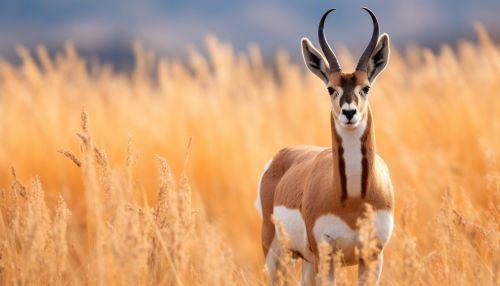Pronghorn
Taxonomy and Evolution
The Pronghorn (Antilocapra americana) is a species of artiodactyl mammal indigenous to interior western and central North America. Though not an antelope, it is often known colloquially in North America as the American antelope, prong buck, pronghorn antelope, or simply antelope because it closely resembles the true antelopes of the Old World and fills a similar ecological niche due to parallel evolution.[1]
It is the only surviving member of the family Antilocapridae. During the Pleistocene period, about 12 antilocaprid species existed in North America. Three other genera existed when humans entered North America but are now extinct.[1]


Description
Adult males are 1.3–1.5 m (4.3–4.9 ft) long from nose to tail, stand 81–104 cm (32–41 in) high at the shoulder, and weigh 40–65 kg (88–143 lb). The females are the same height as males, but weigh 34–48 kg (75–106 lb). The feet have two hooves, with no dewclaws. Their body temperature is 38 °C (100 °F).[1]
The prominent features of the males are the horns, which are made of an outer sheath of hairlike substance that grows around a bony core; the outer sheath is shed annually. Males have a horn sheath about 12.5–43 cm (4.9–16.9 in) (average 25 cm (9.8 in)) long with a prong.[1]
Distribution and Habitat
Pronghorns live primarily in grasslands but also in brushland and deserts. They used to be found throughout the Great Plains, in the desert regions of the Great Basin, and in the Sonoran Desert of Mexico and the United States. The subspecies known as the Sonoran pronghorn (Antilocapra americana sonoriensis) occurs in Arizona and Mexico. Another subspecies, the Mexican pronghorn (Antilocapra americana mexicana), is primarily found in Mexico.[1]
Behavior and Ecology
Pronghorns have distinct white fur on their rumps, sides, breasts, bellies, and across their throats. Adult males have black patches on their faces and necks. Both sexes have a pair of black horns.[1]
Pronghorns are among the fastest animals in North America. They can run at speeds close to 60 mph (97 km/h). Unlike other large animals, such as bison, that lived in the Great Plains and are now confined to parks and reserves, pronghorns are still found in large numbers throughout their original natural range.[1]
Reproduction
Pronghorns have a gestation period of 7–8 months, which is longer than is typical for North American ungulates. They breed in mid-September, and the doe carries her fawn until late May. This is around six weeks longer than the white-tailed deer.[1]
Conservation
The pronghorn is a conservation success story, having been brought back from the brink of extinction in the 1920s. Today, pronghorns number more than a million individuals and are found from southern Saskatchewan and Alberta in Canada south through the United States (almost to the Mexican border) and into northern Baja California Sur, Mexico.[1]
